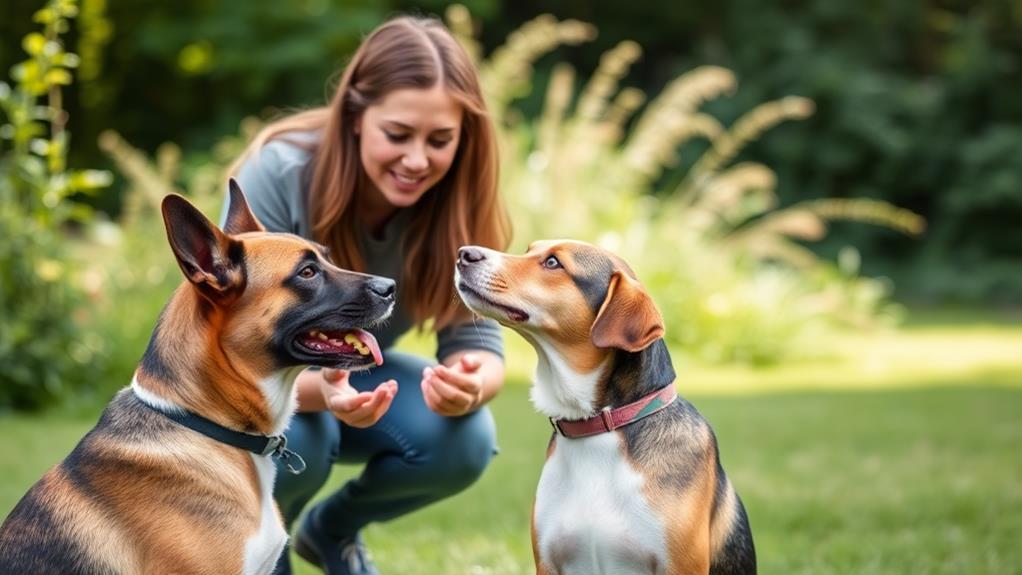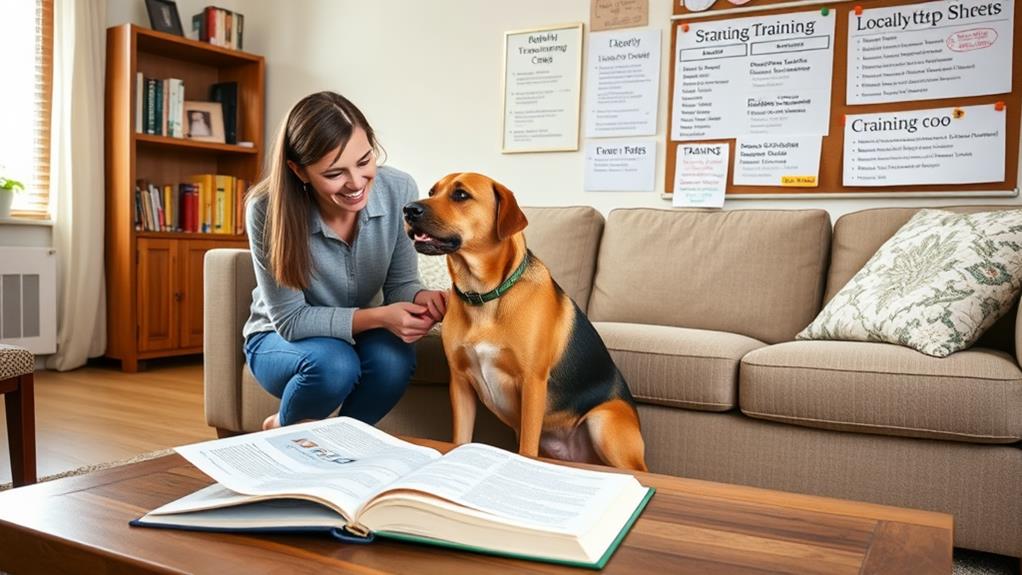Effective dog training boils down to three simple steps that foster a strong bond with your pup. First, establish a training foundation by setting clear rules and using consistent commands like "sit" and "stay." Next, implement effective techniques by rewarding good behavior immediately, maintaining engaging sessions of about 5-10 minutes. Finally, build ongoing support systems by connecting with local trainers and joining community groups. This network helps you troubleshoot challenges and celebrate successes together. With these steps, you'll create a loving environment that nurtures your dog's growth. There's more to explore to guarantee a fulfilling training journey ahead.
Establishing a Training Foundation

To build a solid training foundation for your dog, you need to focus on consistency and clear communication. It's vital to establish rules and boundaries that you can uphold every day. This means everyone in your household should be on the same page about what behaviors are acceptable and which ones aren't. If you let your dog jump on the couch sometimes but scold him at other times, he'll get confused about what you really want.
Next, choose simple commands that you'll consistently use. Words like "sit," "stay," and "come" should be your go-to phrases. Using the same command every time will help your dog understand what you expect. Remember, tone matters too. A cheerful voice encourages your dog, while a stern tone should signal that he's done something wrong.
Implementing Effective Techniques

Implementing effective techniques during training sessions can make all the difference in how quickly your dog learns. Start by using positive reinforcement; reward your dog immediately when they perform the desired behavior. This not only encourages repeat actions but also strengthens your bond. Timing is pivotal, so keep treats handy to guarantee your dog associates the reward with the correct behavior.
Next, maintain consistency in your commands and cues. Use the same words and gestures each time to avoid confusing your dog. If you change commands, it can lead to mixed signals and slow down progress.
Additionally, keep training sessions short and engaging. Dogs, especially puppies, have short attention spans. Aim for 5 to 10 minutes of focused training followed by playtime or a break. This keeps your dog interested and ardent to learn.
Lastly, be patient. Every dog learns at their own pace, and some may require more time than others. Celebrate small victories to keep both you and your dog motivated. With these effective techniques, you'll set a solid foundation for a well-trained and happy companion.
Building Ongoing Support Systems

Building ongoing support systems is essential for successful dog training. You need a network of resources and people who can help you troubleshoot challenges and celebrate successes.
Start by connecting with local dog trainers or behaviorists. They can provide guidance tailored to your dog's unique needs and offer valuable insights that can make a difference in your training journey.
Next, look for community groups, either online or in-person, where dog owners share experiences, tips, and encouragement. Engaging with fellow dog owners can help you remain motivated, and you'll gain access to a wealth of knowledge.
Social media platforms and forums are great places to seek advice or even find training buddies for practice sessions.
Frequently Asked Questions
What Age Is Best to Start Dog Training?
The best age to start dog training is around 8 weeks old. At this age, your pup's brain is like a sponge, absorbing new information. Early training builds strong foundations for good behavior throughout their life.
How Long Should Each Training Session Last?
Think of training sessions like a good book—you're thrilled to plunge in, but too long can lead to boredom. Aim for 5 to 15 minutes, keeping your dog engaged and enthusiastic for more learning.
Can I Train My Dog Using Only Treats?
You can train your dog using only treats, but it's best to mix in praise and play for balance. Treats motivate, but variety keeps your dog engaged and helps reinforce positive behaviors more effectively.
What Common Mistakes Should I Avoid in Dog Training?
Avoiding common mistakes in dog training is essential. Don't skip consistency; it leads to confusion. Also, never ignore your dog's body language—misreading signals can result in setbacks. Stay patient, and remember, progress takes time.
How Do I Handle Behavioral Issues During Training?
When handling behavioral issues during training, stay calm and consistent. Redirect your dog's attention, reward positive behavior, and avoid punishment. Patience is key; it helps build trust and encourages your dog to learn effectively.
Conclusion
By focusing on establishing a solid training foundation, implementing effective techniques, and building ongoing support systems, you can guarantee a successful journey with your dog. Remember, training isn't just a one-and-done deal; it's a lifelong commitment. Treat this experience like a Netflix series—keep the episodes coming! With patience and consistency, you'll both thrive, creating a bond that lasts. So grab those treats and get started on this adventure together!



